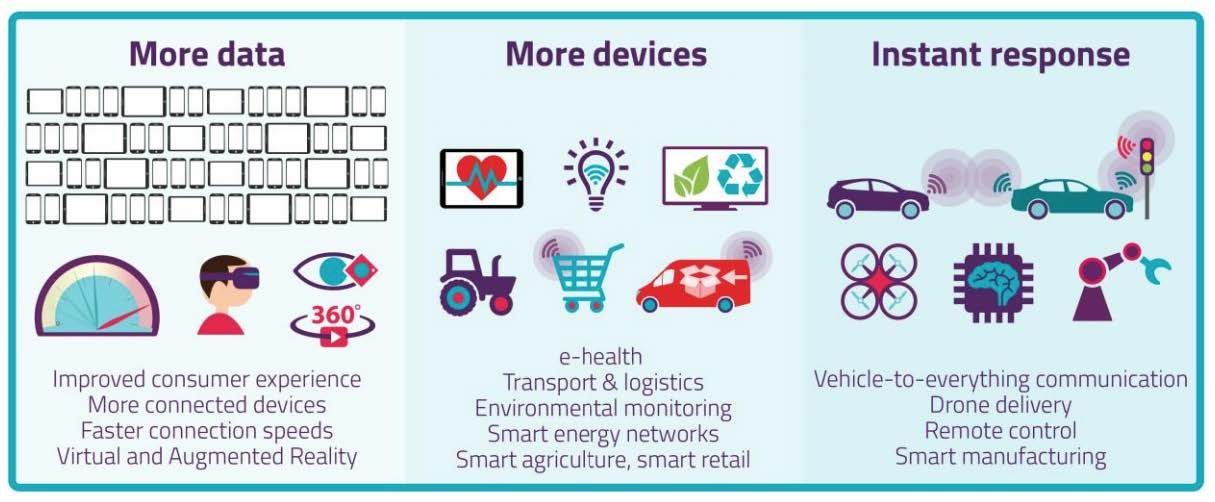Nevertheless, there will still be a large ‘edge of the net’ market to implement infrastructure on private land such as campus sites, estates and associated roads, farmland and industrial complexes. Many of the end clients that our industry serves will wish to install their own ‘cell’ whether via 5G or another wireless network.

With the added capability to transmit ultra-low latency, almost real-time data that would be essential for driverless vehicles & and drones, simple street lighting, street furniture and building rooftops will become radio beacon sites. The scope of infrastructure projects can start to be appreciated. However, for 5G to make a big impact into applications utilising IoT on a nationwide scale, the big carriers that currently deliver broadband services and mobile networks will probably need to re-architect their networks at the core to provide edge computing/micro data centres which have been much talked about.
We may be waiting some time for these advanced developments to become commonplace. Added to this the massive deployment of small cell radio access network (RAN) that will be necessary it will take many years to implement. In the meantime, additional fibre will be required to link up isolated cells.
FTTX is where we’re at
In the UK we have a ready-made infrastructure of BT telegraph poles serving the last mile in rural and suburban areas. Self-supporting lightweight fibre cables known as ADSS (All Dielectric Self-Supporting) optical cables will be the most cost-effective delivery method. These can be significant fibre counts and 32 core seems to be one of the most popular. Termination of this size of cable can be comfortably made in a torpedo joint which can be mounted on the pole of underground. Alternatively, a pole box with sufficient break out glands for ‘drop fibres’ to the premise or radio device can be utilised. It can be seen that although 5G technology will be an important enabler for future smart ‘everything’ it will be a combination of both a radio access network (RAN) and wired infrastructure that will connect up the millions of users and future IoT cells. Whatever the application, there will be a requirement for fibre, and lots of it.
Enabling Smart Cities
The phrase ‘smart cities’ has been banded around for many years now along with smart buildings and the UK, whilst having many initiatives and some good applications, has been generally slow to adopt compared to some countries like Singapore. Whilst cities stand to gain the most from the deployment of 5G technology, it is very costly to deploy the infrastructure in hard, congested cityscapes and schemes have completed for funding at a time of public spending austerity. Several public & privately funded organisations have been set up to drive forward initiatives for Smart Cities. Perhaps one of the best known in the UK is Catapult – Connected Places, previously known as Future Cities.
There are some 150 smart city projects listed globally on the www.nominet.uk site, with 27 of them UK specific. These projects cover a wide spectrum of technologies and applications. One project ‘Bristol is Open’ involved implementing a 30Gb/s broadband network that combines fibre, a wireless 'hetnet', experimental network technologies and a radio frequency mesh network deployed on 2,000 lampposts to create a giant laboratory. Utilising Bristol Universities’ supercomputer it is being used to assist with traffic congestion, air pollution and assisted living for elderly as well as a self-driving car trial.
Within most of these projects, there will be common elements of infrastructure to connect the multiple data nodes. Industrial grade switches at the edge of the network are required to connect to devices and aggregate cell data. As with future broadband deployment, there is likely to be a combination of wired and wireless infrastructure including copper cables delivering PoE. These switches are typically going to be housed in enclosures mounted above ground or street cabinets. Fibre uplinks will connect into the local carrier networks which will most likely be a radio device. The transmission of data will either be via a radio link (e.g. using 4G/5G/Wi-Fi or line-of-sight wireless & microwave) or it will be via underground and overhead fibre optic cables. The physical infrastructure of communication cables, joints, beam splitters and accessories to support these networks are the bread and butter of our industry. In a hard cityscape, mounting cable joints on a pole e.g. street furniture, rather than underground has significant cost benefits over the construction of a jointing pit and is more accessible. However, road crossings mean going underground is unavoidable and with congested ducts, 5G radio and other wireless solutions should come into their own and help to accelerate projects that would otherwise never get off the ground.
What does it mean for installers?
5G tech offers as yet unknown opportunities that will shape the world we live in tomorrow. We can all be a part of this evolution.
References: Figure 1: https://www.ofcom.org.uk/__data/assets/pdf_file/0022/111883/enabling-5g-uk.pdf
Download the full whitepaper here.